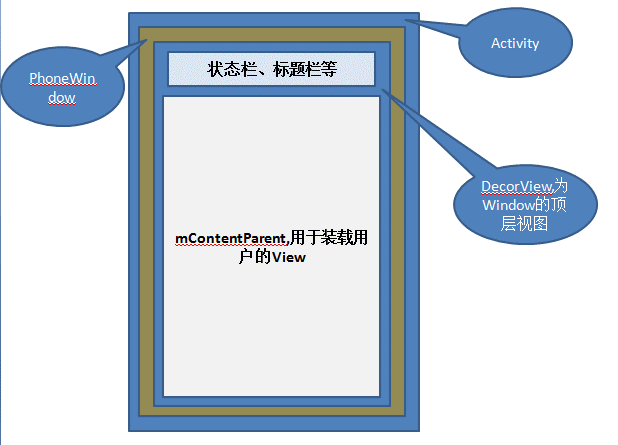Android GUI之Activity、Window、View
相信大家在接触Android之初就已经知道了Activity中的setContentView方法的作用了,很明显此方法是用于为Activity填充相应的布局的。那么,Activity是如何将填充的布局绘制出来的呢?实际上Activity将View的绘制与显示交给了Window对象来处理,下面我们通过源码来进行跟踪分析。
Activity的源码如下,只给出我们关注的部分:
public class Activity extends ContextThemeWrapper implements LayoutInflater.Factory2, Window.Callback, KeyEvent.Callback, OnCreateContextMenuListener, ComponentCallbacks2, Window.OnWindowDismissedCallback { …… …… private Window mWindow; private WindowManager mWindowManager; …… /** * Retrieve the current {@link android.view.Window} for the activity. * This can be used to directly access parts of the Window API that * are not available through Activity/Screen. * * @return Window The current window, or null if the activity is not * visual. */ public Window getWindow() { return mWindow; } …… /** * Set the activity content from a layout resource. The resource will be * inflated, adding all top-level views to the activity. * * @param layoutResID Resource ID to be inflated. * * @see #setContentView(android.view.View) * @see #setContentView(android.view.View, android.view.ViewGroup.LayoutParams) */ public void setContentView(int layoutResID) { getWindow().setContentView(layoutResID); initWindowDecorActionBar(); } /** * Set the activity content to an explicit view. This view is placed * directly into the activity's view hierarchy. It can itself be a complex * view hierarchy. When calling this method, the layout parameters of the * specified view are ignored. Both the width and the height of the view are * set by default to {@link ViewGroup.LayoutParams#MATCH_PARENT}. To use * your own layout parameters, invoke * {@link #setContentView(android.view.View,android.view.ViewGroup.LayoutParams)} * instead. * * @param view The desired content to display. * * @see #setContentView(int) * @see #setContentView(android.view.View, android.view.ViewGroup.LayoutParams) */ public void setContentView(View view) { getWindow().setContentView(view); initWindowDecorActionBar(); } final void attach(Context context, ActivityThread aThread, Instrumentation instr, IBinder token, int ident, Application application, Intent intent, ActivityInfo info, CharSequence title, Activity parent, String id, NonConfigurationInstances lastNonConfigurationInstances, Configuration config, IVoiceInteractor voiceInteractor) { attachBaseContext(context); mFragments.attachActivity(this, mContainer, null); mWindow = PolicyManager.makeNewWindow(this); …… } …… }
PolicyManager的部分源码:
public final class PolicyManager { …… private static final IPolicy sPolicy; static { // Pull in the actual implementation of the policy at run-time …… sPolicy = (IPolicy)policyClass.newInstance(); …… } // Cannot instantiate this class private PolicyManager() {} // The static methods to spawn new policy-specific objects public static Window makeNewWindow(Context context) { return sPolicy.makeNewWindow(context); } …… }
Policy的部分源码:
public class Policy implements IPolicy { …… public Window makeNewWindow(Context context) { return new PhoneWindow(context); } …… }
从给出的源码我们可以看到,Activity内部含有一个Window类型的对象mWindow,当我们调用setContentView方法时,实际上是委托给了Window对象进行处理。Window本身是一个抽象类,它描述了android窗口的基本属性和行为特征。在activity的attach方法中通过mWindow = PolicyManager.makeNewWindow(this)创建了Window对象。通过追踪代码可知, PolicyManager.makeNewWindow(this)实际上是调用Policy中的makeNewWindow方法,在此方法中创建了一个PhoneWindow对象。而PhoneWindow正是Window的子类。他们的关系图如下:

继续追踪源码,PhoneWindow对Window的抽象方法setContentView(int layoutResId)进行了实现,具体源码如下:
@Override public void setContentView(int layoutResID) { // Note: FEATURE_CONTENT_TRANSITIONS may be set in the process of installing the window // decor, when theme attributes and the like are crystalized. Do not check the feature // before this happens. if (mContentParent == null) { installDecor(); } else if (!hasFeature(FEATURE_CONTENT_TRANSITIONS)) { mContentParent.removeAllViews(); } if (hasFeature(FEATURE_CONTENT_TRANSITIONS)) { final Scene newScene = Scene.getSceneForLayout(mContentParent, layoutResID, getContext()); transitionTo(newScene); } else { mLayoutInflater.inflate(layoutResID, mContentParent); } final Callback cb = getCallback(); if (cb != null && !isDestroyed()) { cb.onContentChanged(); } }
在这个方法中我们可以看到首先对mContentParent进行了判断,如果为空的话则调用installDecor方法,通过hasFeature判断window是否具备某些特征,如果窗口不含有FEATURE_CONTENT_TRANSITIONS特征,则清空mContentParent中的所有子元素,为后面加载布局文件到mContentParent中做好准备。通过后面的判断,我们也可以看出无论走那个分支,其实都是对mContentParent布局内容做了更新。由此我们可以推断出mContentParent其实就是我们自己的布局的存放容器,它在PhoneWindow中定义如下:
// This is the view in which the window contents are placed. It is either // mDecor itself, or a child of mDecor where the contents go. private ViewGroup mContentParent;
那么mContentParent是在哪里被创建的呢,很显然是在方法installDecor中,方法installDecor的关键代码如下:
private void installDecor() { if (mDecor == null) { mDecor = generateDecor(); …… } if (mContentParent == null) { mContentParent = generateLayout(mDecor); …… } }
在这个方法中,我们可以看到,首先对mDecor进行判断,如果为空在调用generateDecor方法生成mDecor对象,那么mDecor对象是什么呢?通过查看代码,可以知道mDecor的类型为DecorView,此类型是定义在PhoneWindow中的一个内部类,它继承了FrameLayout。紧接着判断mContentParent是否为空,为空则调用generateLayout并通过传入参数mDecor生成了mContentParent对象。在这个方法中通过应用的主题、窗口特征等来确定使用的布局资源并将使用的布局添加mDecor中,而这些布局中都会含有一个id为content的ViewGroup(FrameLayout),此ViewGroup正是mContentParent,方法关键代码如下:
protected ViewGroup generateLayout(DecorView decor) { …… View in = mLayoutInflater.inflate(layoutResource, null); decor.addView(in, new ViewGroup.LayoutParams(MATCH_PARENT, MATCH_PARENT)); mContentRoot = (ViewGroup) in; ViewGroup contentParent = (ViewGroup)findViewById(ID_ANDROID_CONTENT); …… return contentParent; }
由此我们可以确定,view的显示处理顺序为Activity->PhoneWindow->DecorView->ViewGroup(mContentView)->自定义的View(布局)。
Activity中显示视图的层次结构,具体如下:

疑问咨询或技术交流,请加入官方QQ群:  (452379712)
(452379712)
作者: 杰瑞教育
出处: http://www.cnblogs.com/jerehedu/
本文版权归 烟台杰瑞教育科技有限公司 和博客园共有,欢迎转载,但未经作者同意必须保留此段声明,且在文章页面明显位置给出原文连接,否则保留追究法律责任的权利。











![[HBLOG]公众号](http://www.liuhaihua.cn/img/qrcode_gzh.jpg)

